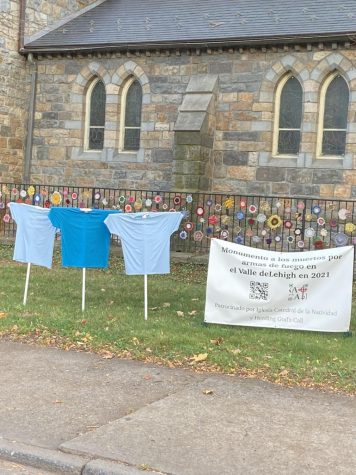Lehigh County ‘Cross’es the Line Between History and Religion

The cross on the flag is surrounded by secular images.
The difference between the freedom of religion and the establishment of religion are relatively ambiguous in the U.S. Constitution. In government classes, students may have heard about Supreme Court cases involving the Ten Commandments posted on governmental property, and praying before a legislative session. Many of us already have opinions on these issues from the viewpoint of an outsider, but what about when the issue occurs in our own county?
The Lehigh County flag and seal were created in 1944. The seal includes a cross surrounded by other symbols of the county, like cows, industrial buildings, and the liberty bell. Nonetheless, the cross is the largest and most noticeable image among its secular background.
In 2016, the Freedom From Religion Foundation filed a lawsuit against Lehigh County in the U.S. District Court of Eastern Pennsylvania, professing that the cross on the Lehigh County seal and flag was an establishment of religion and a violation of the first amendment. Later, the organization filed for a Right-to-Know request, which gives citizens access to specific public records. Freedom From Religion was allowed to access to Lehigh County records and transcriptions of meetings that dealt with the establishment of the seal.
In 2017, Judge Edward Smith ruled that the flag was unconstitutional due to precedent and his application of the Lemon test. Often cited as being outdated, the Lemon test was developed after a landmark case, Lemon v. Kurtzman. Judges use three sets of criterion in order to decide whether religious government speech is an encroachment on the First Amendment, or permissible: does that statute have a secular purpose, does the statute inhibit or aid religion, and does the statute promote government entanglement with religion?
“I’m not sure when establishment clause cases started appearing in court,” social studies teacher Ms. Erin Laney said. “But when [we] were creating a county flag, the establishment clause would have had to cross your mind, given that the county is a government entity.”
The case was recently brought back into light on Friday, September 7. Most recently, Lehigh County attorneys appealed to the 3rd Circuit U.S. Court of Appeals to keep the county seal and flag. One of the biggest questions in the appeal was: “Do Plaintiffs have standing to sue when the only injury they have alleged is a sense of personal affront upon seeing an image of a cross on the County’s seal and flag?”
“[The Lehigh county flag and seal are] like our pledge of allegiance,” sophomore Courtney Bridges said. “It’s like Christmas; we have Christmas trees in public areas, because it’s so separated from what it originally meant. Christmas means the holidays now, not just Christianity. [The situation can be compared with] when Pennsylvania was founded by religious people.”
Lehigh County’s attorney, Eric Baxter, cites the fact that many Christian religious minorities, such as Moravians, Lutherans, and the Dutch, were the first settlers of the Lehigh Valley. Fleeing religious persecution from their homeland, they found safety in the the new world.
“I think the intent of the seal, when it was created in 1944, was to represent the history of the region,” social studies teacher Mr. Thomas Beaupre said. “In 1944, the idea was that Christianity was a big part of this region’s history and culture. They were thinking, ‘Why wouldn’t we out the cross on the seal?’ It was a representation of what the community was about.”
On the other hand, the plaintiff Marcus Schneider asked the panel of judges to consider the context of the flag and the perception of the viewers. Does everyone living in the Lehigh County know about our founding?
“While at the point in history, whenever the flag was made, it would make sense to have a religious figure on the flag,” senior Josiah Johnson said. “Currently, religion is no longer on the forefront of society, and it does not dictate what [all Lehigh County residents] do.”
Additionally, Schneider brought up documents that clarified the purpose of the cross on the flag. A Lehigh County Historical Society record included dialogue from the 1946 Commissioner Harry D. Hertzog, saying that the cross represents “Christianity and the God-fearing people which are the foundation and backbone of (Lehigh) County.” This clarified to the judge that the flag does not have a clear, secular purpose, thus failing one section of the Lemon test.
The Lehigh County’s religious makeup and views on religion have changed dramatically since the flag was made. According to a 2010 study from the Association of Religion Data Archives, 48.2 percent of the Lehigh Valley population are non-adherents to many sects of Christianity, Judaism, and Islam.
Even out of the Christian majority, there are many religious individuals who do not believe religious symbols have a place in our government. Americans United, the American Civil Liberties Union, and the Anti-Defamation League filed a friend-of-the-court brief on behalf of 20 nonprofit organizations, including Christian groups. A friend-of-the-court brief allows outside third parties to offer information and professional opinions that might have bearing on the case.
The appellate case in Philadelphia will not have a decision until later this year, but we can expects changes or consistency based on the judges’ application of the Lemon test. Depending on the outcome, you may see a new flag flying above our courthouse in the near future.

Senior Bridgette Lang is a third-year staff reporter and former features editor, now serving as opinion and our world editor for the Spotlight. In addition,...











